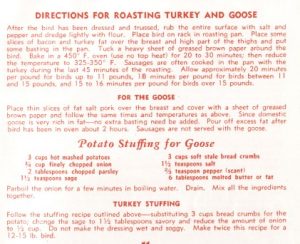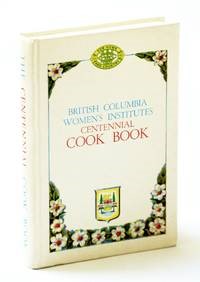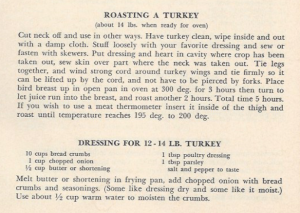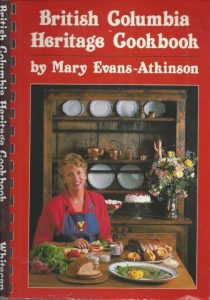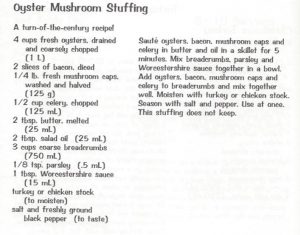Four Ways to Roast a Turkey in BC
Food researchers are increasingly using cookbooks sources for historical, cultural, and sociological data. Some people suggest that one way to approach recipe research is to look at examples of the same recipe from different cookbooks (e.g., Cotter,1997; Leach & Inglis , 2003; Wheaton, 2014)[i] . By examining such factors as the type of cookbook, the title, the ingredients and the directions, the researcher can determine what is assumed about the cookery knowledge and the household and social mores of the time.
Since this is often a season when turkey is on the menu I thought it might be interesting to look at recipes for preparing a Christmas turkey in four BC publications.
Recipe 1.
This is from the BC Electric Home Service Home Service Bulletin booklet titled Christmas Festivities[ii] printed in 1943.
Recipe 2.
The second turkey recipe is from British Columbia Women’s Institutes Centennial Cookbook (1958) created in celebration of BC’s centenary.
Recipe 3.
The third is from British Columbia Heritage Cookbook: a treasury of British Columbia treats.[iii] Printed in 1984 it was written by Mary Evan-Atkinson, a cookbook author.
Recipe 4 is from the 2018 website of the BC Turkey Association which represents British Columbia’s registered turkey farmers[iv]. It is integrated with the website of the Turkey Farmers of Canada.
Roasting a Whole Turkey
- Preheat oven to 350°F (175°C).
- If stuffing the turkey, do so while the oven is preheating. Spoon stuffing lightly into turkey instead of packing firmly because stuffing expands while cooking. (Allow ½ cup (125 ml) of stuffing per pound (500 g) of turkey.)
- Place turkey breast-up on a rack in a shallow roasting pan.
- Roast uncovered, or loosely covered with foil. If you choose to baste your turkey, limit the number of times you open and close your oven (once per hour is sufficient).
- Turkey is cooked when the meat thermometer reads 170°F (77°C) for an unstuffed turkey, or 180°F (82°C) for a stuffed turkey and the juices run clear. Insert meat thermometer in the thickest part of the inner thigh, but not touching the bone.
- When roasting, any stuffing placed in the cavity of the bird should read and internal temperature of at least 165°F (74°C).
- Remove the turkey from the oven when cooking is completed and let stand 20 minutes to allow the juices to set.
Always wash the tongs, plate and thermometer stem used in checking partially cooked meats/poultry before using again.
Comments
What can we learn from these four recipes about the cultural milieu in which they were written?
Recipe 1 comes from what Cooke (2009)[v] classifies as a “cookbooklet,” a small cookbook produced for promotional purposes. By the late 1930’s and 40’s more of these cookbooklets were being produced by corporations and according to Cooke, as home economics was professionalized in Canada in 1939, home economists took up positions as corporate and public spokes-personalities. In this case the spokes-personality was Miss Mutch, a domestic science graduate, from McDonald College in Montreal who was employed by the BC Electric Company to promote the electric home.[vi]
The process of cooking a turkey here is written in a narrative style. It has a friendly tone, as if the author was actually speaking to the cook. The recipe for the stuffing resembles the format we see today, with specific measurements using standardized cups and teaspoons.
The ingredients are fairly standard is that they are items that are often founds in most homes: salt, pepper, bread, butter or fat, simple herbs that may have even been grown in the cook’s garden. If we look at the cookery terms it appears that the author assumes that the cook has some basic cookery knowledge and thus knows how to “dress” and “truss” a bird, and understands what “dredge,” “bastings” and “parboil” means. It is also assumed that cooks would know what equipment to use (e.g., it doesn’t tell you to parboil in a saucepan or mix ingredients in a bowl). It is assumed that most household have stoves where heat can be tightly controlled as wood/coal ovens would not have top heat. Most probably the recipe was designed for an electric stove as BC Electric was promoting the electric home. Since ‘tin’ or aluminum foil was not that common and expensive, the more traditional cover of greased brown paper (probably recycled brown paper grocery bag or parcel wrapping, as “recycling” though not a common descriptor was just the way of life of households who came through the depression and now were experiencing shortages during the war).
So Miss Mutch’s approach here appears to be a bit of a hybrid. The directions for preparing the turkey are very general and directed to an experienced cook but the a more precise recipe for the stuffing commonly indicates the belief that creating a successful product required a more scientific, accurate measurement approach,
Recipe 2 is an example of a community cookbook[vii]. Community cookbooks are compilations of recipes put together by organizations, such as church groups or in this case a women’s service organization, who seek to share practical culinary knowledge. They are also referred to a charity cookbooks as they were often sold to raise funds for a charitable cause. Usually the person who submitted the recipe is recognized by name but in this case each of the districts of the Women’s Institutes in BC prepared various chapters. The members of the District No. 5 Douglas (South-west Fraser) were responsible for the Poultry and Dressings chapter. Because this cookbook was a celebration of the work of Women’s Institutes each chapter included a historical account of the area and the organization’s activities there. It’s claimed that community cookbooks provide a uniquely accurate record of Canadian life because they reflect the tastes and cooking practices of the home cooks who contribute the recipes[viii]. In doing so they challenge the traditional notion of cookbook authors and home economists as voices of authority on food preparation.
Similar to recipe 1, the ingredients are very basic and easily obtained. The directions for preparing the turkey are more detailed and they do not take for granted that a cook would know how to “dress” and “truss” the bird. Instead more specific directions are given: how to clean; how to close the opening (sew or skewer); how to tie the legs and wings; and so on. This recipe recommended cleaning the bird and wiping with a damp cloth which is now not recommended as it just spreads any bacteria that may be present throughout the kitchen.
There is no mention of basting but a rationale is given for turning the bird over so this technique is probably recommended so that basting is not required. The attention to tying with “strong cord” is so it can be lifted by the cord is probably important to hold the bird together and facilitating turning over. It does appear that meat thermometers are common household equipment. The temperatures given are rather high in comparison to today’s recommendation (see recipe 4).
The dressing recipe remains very basic in terms of ingredients but the instruction include the equipment (frying pan) to be used. It does encourage the cook to modify the amount of moisture to suit their taste when it says “about ½ cup warm water” and “some like dressing dry and some like it moist”.
Recipe 3 is an example of a commercial cookbook, published for profit. The author takes responsibility for testing and standard formatting of the recipes and in this way asserts her authority as expert. In this cookbook the author indicates that the recipes have been obtained from British Columbians and some of the recipes titles include the name of the originator or the place. It is described on the back cover as “the first book to explore, in depth, the unique regional cooking of British Columbia.” Cookbooks of this nature provide the opportunity for an individual to articulate and even construct, an emerging sense of shared identity[ix]. This is the only recipe that indicates that it is specifically for Christmas.
This recipe follows the standard format for cookbooks with the list of ingredients and then directions for both the turkey and the stuffing. But similar to the other recipes the cook is assumed to have some prior knowledge. For example, the cook would know not to preheat the oven before brining the turkey since it is to be soaked in salt water for 3 to 4 hours. It is also assumed the cook knows how to sauté, baste, make gravy, and how to calculate cooking time for a turkey.
The process of soaking in a salt solution, known as brining, puts this recipe ahead of the times as brining didn’t really gain popularity until the 1990s and has since fallen out of favour.[x] The steps for brining are quite detailed which would lead us to believe that it wasn’t a common procedure at that time.
This is a more opulent recipe calling for more expensive ingredients – champagne for the turkey and fresh oysters and fresh mushroom caps for the stuffing giving an indication of improved accessibility of ingredients by the 1980’s and a higher standard of living than the two previous time periods. Aluminum foil has now become a common household item.
The tradition of oyster dressing was brought over from Britain by colonists that settled in Canada (and in the US). Directions for the dressing include the utensils to be used such as skillet and bowl.
Recipe 4 is an example of an on-line cookbook created by a commodity group in order to promote consumption of their product. All the recipes on the site have turkey as the main ingredient.
Commodity groups have a long history of providing recipes and culinary advise to homemakers. Frequently their spokesperson has been a home economists but with the decline of home economics degree programs across the country it is more likely the spokesperson has a “home economics related degree” (i.e., background in food science, nutrition, dietetics, etc.). This recipe is written in typical recipe format and accompanied by instructional videos[xi] Turkey Basics: How to Cook a Simply Delicious Roast Turkey and Turkey Basics: How To Use A Digital Thermometer. The steps are now numbered instead of the narrative style which makes the recipe appear more scientific and methodical, not leaving anything up to interpretation. The tools to use for each step are also clearly specified. However in this recipe there are still some decisions the cook can make, for example whether to stuff, whether to use foil or not, and whether to baste or not. There is an assumption that most cooks would know what stuffing is and how to baste.
There is a greater emphasis on food safety with internal temperatures of cooked turkey in bold type, and inclusion of a food safety tip for washing tools that have come in contact with uncooked or partially cooked turkey. The accompanying videos also highlight washing one’s hands after handling the bird.
Regardless of their purpose collections of recipes whether they be cookbooklets, hardcover cookbooks or are available via digital technology, all serve to consolidate knowledge gleaned from various sources for home cooks. While these examples show increasing precision in measurements and descriptions of process and varying assumptions of what a cook has available and can do, there is still some acknowledgement that cooking is a creative process. How do you cook a turkey in BC?
[i] Cotter, C. (1997). Claiming a piece of the pie: How the language of recipes defines community. In A. Bower (Ed.). Recipes for reading: Community cookbooks, stories, histories (pp. 51-71). Amherst, MA: University of Massachusetts Press; Leach, H. M. & Inglis R. (2003). The Archaeology Of Christmas Cakes. Food & Foodways, (11),141–166; Wheaton, B. K. (2014). Cookbooks as Resources for Social History. Food In Time and Place: The American Historical Association Companion to Food History, 276-295.
[ii] The complete booklet is available at http://wartimecanada.ca/document/world-war-ii/recipes/recipe-ideas-bc-electric
[iii] Evans-Atkinson, M. (1984). British Columbia Heritage Cookbook: A treasury of British Columbia treats. North Vancouver, BC: Whitecap Books.
[iv] https://bc.canadianturkey.ca/wholebird/roasting-a-whole-turkey/
[v] Cooke, N, (2009). Cookbooklets and Canadian Kitchens, Material Culture Review 70 (Fall), 22-33. https://ssrn.com/abstract=2694241
[vi] See https://bcfoodhistory.ca/utility-companies-home-economists/
[vii]Bower, A. (1997). Recipes for Reading: Community Cookbooks, Stories and Histories. Amherst, MA: University of Massachusetts Press; Nussel, J. (2006). Heating Up the Sources: Using Community Cookbooks in Historical Inquiry. History Compass 4/5, 956–961
[viii]. Iacovetta, F., Korinek, V.J. & Epp, M. (2013). (Eds.) Edible histories cultural politics, towards a Canadian food history (pp. 173-188). Toronto: University of Toronto Press; Mosby, I. (2012). Speak, recipe: Reading cookbooks as life stories. Retrieved from http://activehistory.ca/2012/08/speak-recipe-reading-cookbooks-as-life-stories/.
[ix] Cooke, N, (2009). Cookbooklets and Canadian Kitchens, Material Culture Review 70 (Fall), 22-33. https://ssrn.com/abstract=2694241
[x] See https://www.nytimes.com/2018/11/12/dining/the-rise-and-fall-of-turkey-brining.html
[xi] See https://bc.canadianturkey.ca/turkey-basics-videos/?v=0-WkqaNgI1c

